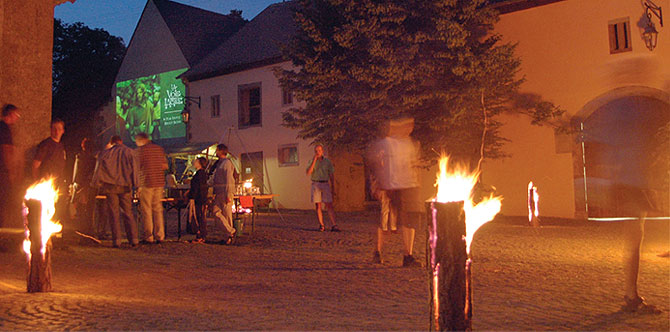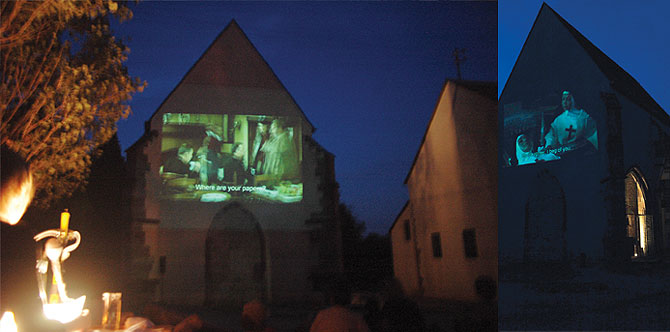10
summer – aestas
LightTimeGame
The Milky Way (La voie lactée)

As already discussed in some of the previous events, according to the current findings of architectural research, the Wintringer Chapel is connected to the Way of St. James, which has now been recognized by UNESCO as a spiritual world heritage site. This European cultural route touches the "chapel" on the route from Speyer to Metz.
The tenth event - dedicated to summer - was therefore once again the starting point for a cultural project, with the medium of film taking center stage for the first time.
Based on the fact that culture can have meaning for a building or a building for culture, and that at times surfaces and space can merge into a unity, the idea developed to project a "play of light" onto an exterior wall (west wall) of the medieval chapel on a summer night, which also deals with the subject of the cult of St. James.
In the starry night sky, visible on clear nights, a cloud of stars, "the Milky Way," runs across a large part of Europe. In the Middle Ages, this was seen as a cosmic reference to the tomb of St. James. The Way of St. James is therefore also called the Way of the Stars.

Luis Buñuel, one of the outstanding directors of the 20th century, dealt with this theme in his own way in his film "The Milky Way" (La voie lactée, 1969). Among the most important aspects of his cinematic work was also the critical examination of the Spanish bourgeoisie and Christianity. This is also expressed in this film. Two tramps who set out on a pilgrimage from Paris to Santiago de Compostela in Spain are at the center of this philosophical-religious treatise. Along the way, they make an (imaginary) journey through Catholic Church history, full of quotations...
The film was projected onto the western façade under a starry sky in the original French version with English subtitles and was spoken in German by an interpreter. A nightly "LichtZeitSpiel" of a special kind, was the headline of the press.

The cooperation partner for this unusual LichtZeitSpiel was the Saarbrücken cinema achteinhalb, whose initiators Ingrid Kraus and Waldemar Spallek succeeded in finding the original version, which was almost out of print, and in ensuring the technical requirements for projecting the film onto the west façade.
Projection: Timo Burkholz, Theodor Wülfing
Simultaneous translation of the English subtitles into German: Nina Steinbach
Internet: www.kinoachteinhalb.de

The event was integrated into a summer festival on the summer solstice (St. John's Eve) at the Wintringer Chapel. As has been the custom in the Saarland since pre-Christian times, a St. John's fire was lit on the farm to "help the light overcome its momentary weakness" during the night. In addition to the traditional market stall, which provided guests with culinary delicacies made from Wintringer farm products at every event, the jazz duo Cornell Wegmann/Bernd Dahlmanns spread a summery lightness with their music. The information on the history of the development of the Wintringer Chapel was enriched by a documentary film at the summer event: As part of the overall documentation of the project - Book of Hours - the documentary film "The Wintringer Chapel" was already completed on the occasion of the LichtZeitSpiel event in cooperation with the Saarbrücken filmmaker and designer Klaus Schneider. This film documents the history of the development of the former Premontratenserpriorat Wintringen up to the present. It was premiered in the pre-show of the evening light show in the "Kapelle". Source of supply: peter.lupp@rvsbr.de
